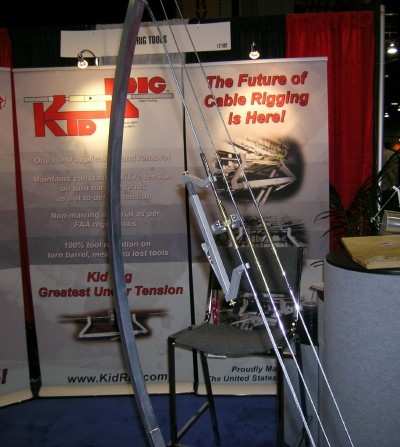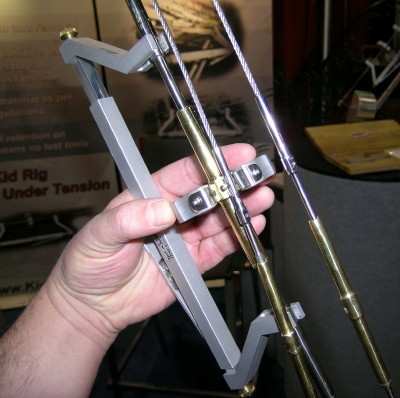A&P-Designed Tool Simplifies A Tough Job
If you make mechanics do something awkward for long enough, one
of them's going to turn into an inventor and solve the whole
problem. That's what happened when "Hollywood" Perin finally got
tired of the grief involved in adjusting cable tension on the
Boeing 737s he works on for a major airline.

Cable rigging is important to safe flight -- there have been
fatal mishaps because a cable was not tensioned properly. Rigging
needs to be checked, and usually adjusted, at each periodic
inspection. So anything that makes rigging easier will find a happy
home in many toolboxes.
Try to visualize how the thing is usually done. Control cables
are normally tensioned by putting a tensiometer on the cable and
then using an adjusting tool. The most common tool resembles two
C-clamps joined by a length of bike chain. First, any slack is
removed from the cable. Then, one clamp is fastened to each
turnbuckle end to hold them in alignment. Then, a wrench is used to
turn the turnbuckle But this arrangement, while it allows a
mechanic to tension the cable, has some downsides:

- The clamps take two hands to put on and can be hard to use in
the tight spaces where these turnbuckles live (for instance, in the
nose gear compartment of that 737).
- Usually there's enough other stuff in the way that it's very
difficult to swing most wrenches very far. It can be hard on an
A&P's knuckles.
- And you're constantly removing and replacing the wrench and
that increases the likelihood that you drop it -- and everything
stops until you can find it again. You can't leave a tool inside an
airplane.
That's not the only potential problem. An alternative tensioning
tool has a spring in place of the bike chain. It has all the above
problems, plus puts tension of its own on the cable which can
interfere with getting a proper reading on the tensiometer.
Enter Kid Rig.
Kid Rig is a two-part tool which can be attached to a turnbuckle
entirely one-handed. Once it's snapped into place, no part of it
can fall off until you deliberately take it off. To operate it you
turn a speed-wrench with your fingers, and again, operation is
entirely one-handed.

It has a cleverly designed multi-sized end that handles the
turnbuckle ends that A&P's know as "3, 4 5 and 6," sizes. The
full nomenclature for the turnbuckle ends is
MS21260-S3,-S4,-S5,&-S6 (same as NAS669) -- they come in long
and short varieties, both of which this tool handles by having two
sets of interchangeable "anvils" or jaws -- and for the bodies
MS21251(same as NAS649; again, both long and short varieties are
supported.
When you slip Kid Rig into position, it automatically mates with
the right size jaws. The more you look at the tool, the more you
see the originality of its concept and design details. (Some Kid
Rig features are patent pending).
The material is high-silicon 6061 aluminum, which won't mar or
scratch the cable turnbuckles. It meets the MilSpec non-mar
requirement. "A scratch creates a stress riser, and can lead to
cracks," Hollywood warns. All parts are machined from billet
stock.
I have to admit, I have never tensioned a 737 control cable in
my life, and probably never will. But what caught my eye was the
bow-shaped display showing the tool off. It turns out, Hollywood
("That's been my nickname for so long even my family calls me
that") fabricated that too. "That shine is polished aluminum. I
bent it on 3/4 inch tools and you can see it's one inch square
tubing... that was a challenge."
"I love building things. I've built cars, race cars, bikes, and
airplanes -- well, I've helped build airplanes." Having seen the
workmanship he puts into a tool and a display stand for same, I
wouldn't question the airworthiness of anything he worked on.

The gleaming bow hosts three cables with different sized
turnbuckles and passersby are invited to try it. (The one perfect
addition to this demonstration would be one of the old tools for
hands-on comparison). This cable-tensioning neophyte had the hang
of it in seconds (after sufficient dual instruction to satisfy the
insurers, of course). Trying it hands-on makes the utility of the
tool apparent (for those who can't try it personally, there's a
brief video on the Kid Rig website, linked below).
Kid Rig is only the first product from Kid Rig LLC, Hollywood
promises. The next will be a Kid Rig cable tensioner that works
just like the present model, but handles smaller turnbuckles, and a
larger one "for that big Number 8 size they have on the
Airbus."
"Yeah," said a showgoer, whose informed questions had already
marked him as another line A&P. "It is a big one. But there's
only that one cable to do on the Airbus."
"But isn't that one a pain in the neck to get at?" Hollywood
countered.
"Yeah," the mechanic said. "Yeah, it is," and he took one of
Hollywood's cards.
 ANN's Daily Aero-Linx (05.02.24)
ANN's Daily Aero-Linx (05.02.24) ANN's Daily Aero-Term (05.02.24): Touchdown Zone Lighting
ANN's Daily Aero-Term (05.02.24): Touchdown Zone Lighting Aero-News: Quote of the Day (05.02.24)
Aero-News: Quote of the Day (05.02.24) ANN FAQ: Contributing To Aero-TV
ANN FAQ: Contributing To Aero-TV NTSB Final Report: Cirrus Design Corp SR20
NTSB Final Report: Cirrus Design Corp SR20






